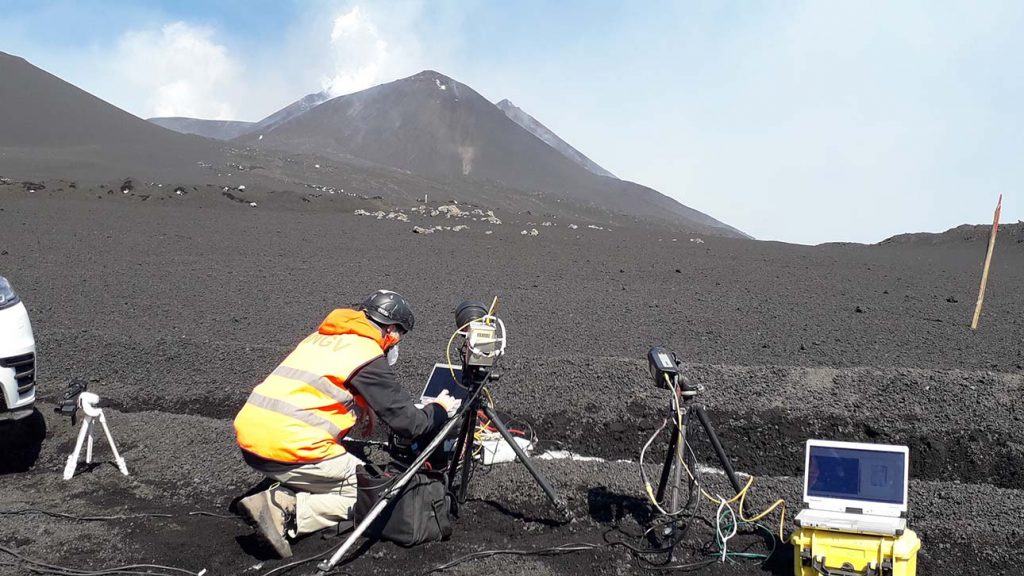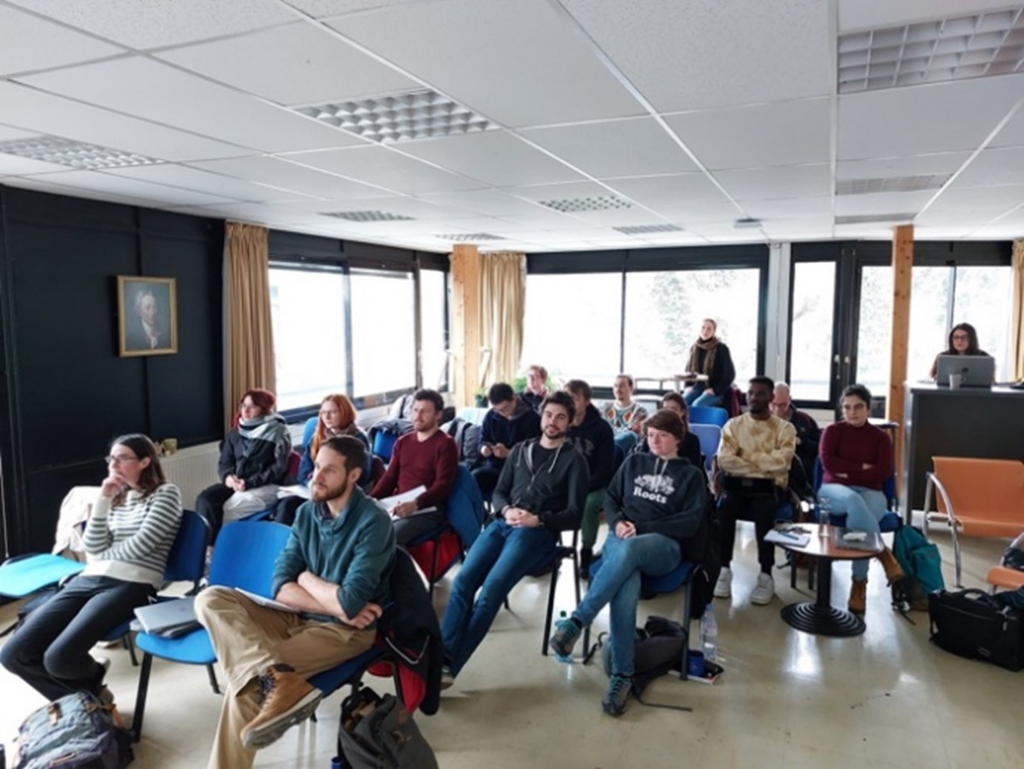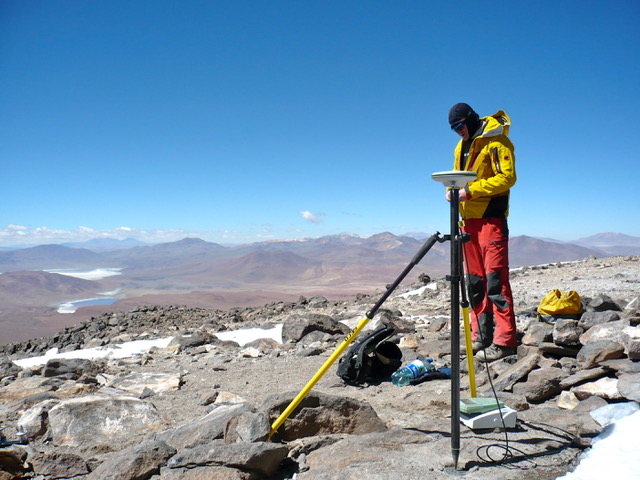
Fourth Specialized Short Course: Petrophysical Properties – from the laboratory to the field and modelling





The IMPROVE field experiment on Mount Etna took place from July 23 to August 2, 2023. All of the IMPROVE ESRs actively participated in the experiment, which involved deploying instruments, periodically checking their functionality, downloading data and starting their analysis, and finally dimantling the instrumentation. The organization of the experiment primarily involved personnel from INGV – Etnean Observatory, with secondary support from personnel from INGV Pisa. The experiment mainly focused on two aspects of the shallow Mount Etna dynamics: its degassing and the movement of magma.
The instruments deployed during the experiment included: two broadband seismic stations, four high frequency GNSS receivers, one clinometer and one diffused degassing measurement device, two seismic arrays with ~100 nodes, an about 1 km long fibre optic and dedicated acquisition system, and finally a high speed visible and an infrared camera plus microphone positioned on the crater rim. This network worked together with the permanent monitoring network of the INGV Etna Observatory, consisting of about 200 multi-parametric instruments. The collected data provide the basis for the analyses by six ESRs who are developing their PhD on Mount Etna. Initial analyses triggered vivid discussion, particularly in the context of numerical solutions for the dynamics of magma convection in underground volcanic systems.
The experiment also included a two-day field trip aimed at providing the ESRs with an understanding of the structural complexities that characterize an active volcano. Specifically, the trip focused on the major structures along the North-East and East volcano flanks of Mount Etna and how these structures impact the setup of a volcano monitoring system.




The Etna IMPROVE school took place from July 24th to July 28th, 2023, in Nicolosi, on the flank of Mount Etna. It was held at the INGV building, as well as in the nearby premises of the conference center of the Nicolosi municipality, which were generously made available. The school was attended by a total of 30 students, consisting of the 15 IMPROVE ESRs and an additional 15 external students who were selected through an open call from among nearly 40 applications received.
The students were trained in the use of sophisticated software, representing the culmination of several years of research and technological development at INGV and partner universities. The ultimate goal was to provide the students with as much practical training as possible in “multiparametric volcano monitoring, data processing, analysis, and modeling”. The first day was dedicated to lessons and exercises on volcano deformation, complemented by a demonstration of the EPOS portal (https://www.epos-eu.org/dataportal) for accessing multi-parametric data from Earth observation systems, including data from volcano observatories. The second day was dedicated to volcano degassing, the fourth day focused on volcano seismicity, and the fifth day involved a simulation exercise. During the exercise the different groups of students simulated a real volcano observatory dealing with a volcanic crisis, and had to use the instruments and tools provided and taught during the school to respond to the crisis. In the late afternoon, each group presented their results together with different statements prepared by them for communication to civil protection authorities and to the media, with ample discussion with senior researcher, particularly those from the INGV Etna Volcano Observatory. The third day of the school was dedicated to the field trip to Mount Etna. The trip was led by Boris Behncke from the Etna Observatory, who presented with engaging and compelling attitude the history and evolution of the volcano, adding stories and anecdotes about recent and past eruptions as well as about volcanologists who worked on the volcano.

The IMPROVE Open Day took place on May 17, 2023, at the Foy Centre in Carlingford, Ireland. Its goal was to engage and spark interest among various audiences, including primary and secondary school students, as well as the local community. The audience was involved in experiments led by IMPROVE ERSs, alongside other PhD students joining them, covering various aspects of volcanology and seismology.
The children generated their own earthquake by jumping on the floor and then observed the corresponding seismogram on a screen. Moreover, they had the opportunity to view live earthquakes from around the world on the Raspberry Shake website. Two trays of jelly and premade ‘buildings’ constructed from sticks and marshmallows were used to mimic various earthquake-resistant structures.
Slinkys and ropes were utilized to illustrate various types of seismic waves and their propagation, while different waveforms on the spectrogram were displayed using a keyboard and a guitar.
The children also observed a cross-section of a volcano created using a fish tank and various other materials designed to represent the internal composition of a volcano. They were able to examine several volcanic specimens, appreciating the density differences between tuff and basalt samples and learning about the magnetism associated with specific rocks. The rheology of magma was explained using Oreo cookies, and volcanoes were created using an old glass bottle, expanding foam, and paint. The eruption was instead simulated using vinegar and baking soda. An experiment was set up with water, ketchup, and honey in plastic cups, and air was blown into them using a straw to demonstrate the different viscosities of various fluids. A CO2 meter was also introduced to simulate the increasing CO2 levels during an eruption. Finally, the children witnessed an outdoor volcano eruption: a traffic cone was transformed into a real-life volcano. Inside the cone, Pepsi and Mentos were mixed together to create a highly explosive eruption!
The day attracted a total of 213 primary school students and members of the public. There were 182 students from two primary schools, along with 22 teachers and assistants in attendance. The feedback from the participants was extremely positive. The children found the day to be a fun and educational experience, and the teachers and staff appreciated the organization and management of the Volcano Open Day. Overall, it was a highly successful and beneficial public outreach event.




The school focused on geophysical data inversion and numerical modeling, by exploring both theoretical and practical aspects of these techniques. Examples from seismic and acoustic source estimations, volcano deformation, and volcano imagery using seismology and magneto-tellurics were used. The school also compared physics-based and data-driven inversion approaches, as well as new hybrid inversion methods incorporating deep learning and physical laws. Additional soft-skill elements of training included project management, research leadership, and effective communication.
A field trip to the Giant’s Causeway, on the coast of Northern Ireland, was organized to observe interlocking basalt columns. The field trip was led by Dr Michael J. Simms, Senior Curator of Geology at National Museums Northern Ireland, and Dr Mark Cooper, Chief Geologist at the Geological Survey of Northern Ireland (GSNI).
On the 17th of May an IMPROVE Open day was held in the Foy Centre in Carlingford, engaging primary and secondary school students as well as the local community. The day attracted a total of 213 primary school students, their teachers, and members of the public. The school students presented experiments and measurement in seismology, rock magnetics, buoyancy, wave propagation, using a variety of materials from natural rocks to different fluids. The teachers and staff commented on how organized and well run the Volcano Open day was. Overall, it was a highly successful and beneficial public outreach event.

IMPROVE is a H2020 Marie Sklodowska-Curie Innovative Training Network for the next generation of European volcanologists. Early Stage Researchers in IMPROVE are trained while developing research on quantitative volcanology, from innovative monitoring and prospecting to advanced lab experiments, High Performance Computing, Machine Learning and Artificial Intelligence. IMPROVE organizes schools, short courses, and other training and scientific meetings open to participants from outside the network.
The Etna school aims at introducing the students to the analysis of data from multiparametric volcano monitoring networks. The school is focussed on exercises and practice: frontal lessons are kept to a minimum, and they are addressed at providing the fundamental understanding necessary for a conscious use of processing tools and computational instruments which will constitute the core of the activities. The case studies will make large (but not exclusive) reference to Mount Etna, one of the most active, best monitored, most famous and most intensively investigated volcanoes in the world. The technical and scientific contents above are complemented by lessons on European standards for data management and policies, and on planning, engineering and testing new instruments for volcano monitoring.
All students are asked to bring a poster on their research activity, and present it in dedicated sessions.
| July 23 | Arrivals (late afternoon) & ice-breaker |
| July 24 | Volcano deformation: theory and exercises Late afternoon students’ posters & wine session. |
| July 25 | Volcano degassing: theory and exercises Late afternoon students’ posters & wine session. After-dinner presentation of the field excursion. |
| July 26 | Field excursion on Mount Etna. |
| July 27 | Volcano seismicity: theory and exercises Afternoon training module on the EPOS data portal. Late afternoon students’ posters & wine session. |
| July 28 | Final exercise: simulation of a volcanic crisis. |
| July 29 | Departures in the morning |
Mount Etna (3357 m a.s.l.) is one of the most famous and active volcanoes in the world, and one of the most beautiful to visit and most rewarding to investigate. The eruption activity during last few decades is dominated by the formation of large lava fountains merging into sub-Plinian events with volcanic plumes reaching as high as 15 km above the crater. Quite often that summit activity is accompanied by the generation of lava flows, most of which invade the “Valle del Bove”, a huge depression on the Eastern flank of the volcano representing a major volcano-tectonic feature. Less frequent flank eruptions produce lava flows which menace, and sometimes partially destroy, villages as well as touristic installations.
The volcano monitoring system on Mount Etna is arguably the most developed in the world, with a number of permanent installations approaching 200 and including broad-band seismometers, tiltmeters, dilatometers, gravimeters, GNSS, FTIR and multi-gas sensors, acoustic sensors, visible and infra-red cameras, integrated by satellite imagery (optical and radar) and field observations. The 24/7 volcanic control room at the INGV Etna Observatory in Catania continuously receives Tb of data which are processed in real-time, and is constantly in contact with the regional and national operational rooms of the Italian Civil Protection system.
Comitato organizzativo: Eugenio Privitera, Giuseppe Puglisi, Paolo Papale, Raffaela Pignolo.
Supporto tecnico: Massimiliano Cascone, Patrizia Pantani, Salvatore Consoli, Fabrizio Pistagna.
Each student will pay a contribution to the true costs, amounting to a total of 430 euros to be payed on-site, inclusive of accommodation in double or triple room, breakfast, lunch, coffee breaks, social dinner, school materials, transfer from-to Catania airport at scheduled times, and additional transfers during the school days. The cable car to access the summit area of Mount Etna during the day of field trip costs additional 45 euros, to be payed on-site to the service-providing company.
INGV building, Via Monti Rossi 1
NICOLOSI (CT)/

On 21-23 January 2023 at ISTerre, Grenoble (France) took place the first IMPROVE Specialized Short Course. The course was organized an managed by organized by Stéphane Garambois and Jean Vandemeulebrouck. It focused on the new techniques developed in seismology (ambient noise, DAS, covariance techniques), on seismic tomography, on the acquisition and processing of geophysical data from the European data centers and on complementary imaging methods, magnetic, electrical and electromagnetic, applicable to volcanoes and geothermal areas. 9 of the 15 ESRs from IMPROVE project attended this course together with further 8 PhD students from the doctoral school STEP (Sciences de la Terre, de l’Environnement et des Planètes) of University Grenoble Alpes

The Second Specialized Short Course on Volcano Geodesy was held at the School of Earth Sciences, University of Bristol (UK) at the end of March. It was organized by Prof. Joachim Gottsmann, and attended by 8 IMPROVE ESRs plus 8 external students.
The course focussed on techniques for monitoring volcano deformation, including ground-based and satellite-based methods, as well as on data interpretation using mathematical modeling and both forward and inverse approaches. The participants were introduced to increasingly complex approaches from analytical to numerical computation and analogue experiments of volcano deformation, and could analyse and test themselves the relevance of different assumptions on crustal mechanics and rheology in determining ground deformation at active volcanoes.